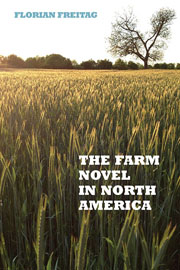 The Farm Novel in North America
The Farm Novel in North America Book contents
- Frontmatter
- Contents
- Acknowledgments
- Introduction
- 1 Surveying the Fields
- 2 Early Sowings: St. John de Crèvecocur's “History of Andrew, the Hebridean,” Patrice Lacombe's La terre paternelle, and Susanna Moodie's Roughing It in the Bush
- 3 Laws of Nature: Frank Norris's The Octopus, Albert Laberge's La Scouine, and Frederick Philip Grove's Settlers of the Marsh
- 4 New World Demeters: Willa Cather's O Pioneers!, Louis Hémon's Maria Chapdelaine, and Martha Ostenso's Wild Geese
- 5 Rich Harvests: Joseph Kirkland's Zury: The Meanest Man in Spring County, Claude-Henri Grignon's Un homme et son péché, and Frederick Philp Grove's Fruits of the Earth
- 6 Fields of Crisis: John Steinbeck's The Grapes of Wrath, Félix-Antoine Savard's Menaud, maître-draveur, and Robert J. C. Stead's Grain
- 7 The Cycle of Seasons: Louis Bromfield's The Farm, Ringuet's Trente arpents, and Grace Campbell's The Higher Hill
- Epilogue
- Works Cited
- Index
6 - Fields of Crisis: John Steinbeck's The Grapes of Wrath, Félix-Antoine Savard's Menaud, maître-draveur, and Robert J. C. Stead's Grain
Published online by Cambridge University Press: 05 December 2013
- Frontmatter
- Contents
- Acknowledgments
- Introduction
- 1 Surveying the Fields
- 2 Early Sowings: St. John de Crèvecocur's “History of Andrew, the Hebridean,” Patrice Lacombe's La terre paternelle, and Susanna Moodie's Roughing It in the Bush
- 3 Laws of Nature: Frank Norris's The Octopus, Albert Laberge's La Scouine, and Frederick Philip Grove's Settlers of the Marsh
- 4 New World Demeters: Willa Cather's O Pioneers!, Louis Hémon's Maria Chapdelaine, and Martha Ostenso's Wild Geese
- 5 Rich Harvests: Joseph Kirkland's Zury: The Meanest Man in Spring County, Claude-Henri Grignon's Un homme et son péché, and Frederick Philp Grove's Fruits of the Earth
- 6 Fields of Crisis: John Steinbeck's The Grapes of Wrath, Félix-Antoine Savard's Menaud, maître-draveur, and Robert J. C. Stead's Grain
- 7 The Cycle of Seasons: Louis Bromfield's The Farm, Ringuet's Trente arpents, and Grace Campbell's The Higher Hill
- Epilogue
- Works Cited
- Index
Summary
When the Great Depression hit North America in the 1930s, there were many who considered the farm a refuge from urban misery and poverty, a place where living on and off their own land, people would enjoy a certain measure of self-sufficiency and dignity in spite of the economic crisis. North American farm novels from the Depression era responded to this agrarianist idealization of the rural space with a “revolt from the farm,” by depicting the farm as a place that was troubled by crises of its own. These included “natural” crises, such as droughts, floods, fires, crop diseases, soil erosion, and insect epidemics, but also “man-made” economic and social crises, as, for instance, market price fluctuations for crops, mortgage foreclosures, or even religious persecution. Far from being a safe alternative for the victims of the Depression and especially the urban poor and unemployed, farm life is depicted in Depression-era farm novels as an economically precarious existence, dominated by a seemingly never-ending fight for the land, with the farmer constantly threatened from all sides with the loss of ownership of his soil.
In addition to addressing the question of what constitutes rightful ownership of the land—legal titles, the “moral” right to ownership of those who work the land, or, especially in French Canadian farm novels, the “moral” right to ownership of those who inherited the land from their ancestors—farm novels from this time also debate how the farmer's enemies may be fought.
- Type
- Chapter
- Information
- The Farm Novel in North AmericaGenre and Nation in the United States, English Canada, and French Canada, 1845-1945, pp. 224 - 267Publisher: Boydell & BrewerPrint publication year: 2013
